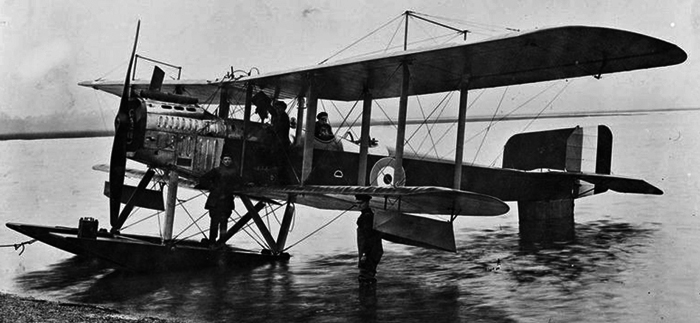
The Fairey Campania: Tailored for a first carrier
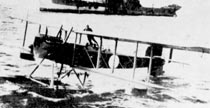 The Fairey Campania was a ship-borne, patrol and reconnaissance aircraft, single-engine, two-seat with two main floats, backward-folding wings, the first aeroplane ever designed specifically for carrier operations. Naturally after seeing HMS Campania, here is the RNAS bird named after her: The Fairey Campania. First successful model of the company, it was ordered by the admiralty for the RNAS at the time, specially to serve on the aircraft carrier, but she appeared late in the war, as a reconnaissance and bomber aircraft. Only 62 were built and they were retired in 1919. ../../../naval-aviation/ww1/uk/fairey-campania.php #rnas #royalnavy #fairey #faireycampania #ww1 #greatwar #navalaviation
The Fairey Campania was a ship-borne, patrol and reconnaissance aircraft, single-engine, two-seat with two main floats, backward-folding wings, the first aeroplane ever designed specifically for carrier operations. Naturally after seeing HMS Campania, here is the RNAS bird named after her: The Fairey Campania. First successful model of the company, it was ordered by the admiralty for the RNAS at the time, specially to serve on the aircraft carrier, but she appeared late in the war, as a reconnaissance and bomber aircraft. Only 62 were built and they were retired in 1919. ../../../naval-aviation/ww1/uk/fairey-campania.php #rnas #royalnavy #fairey #faireycampania #ww1 #greatwar #navalaviation
Design History
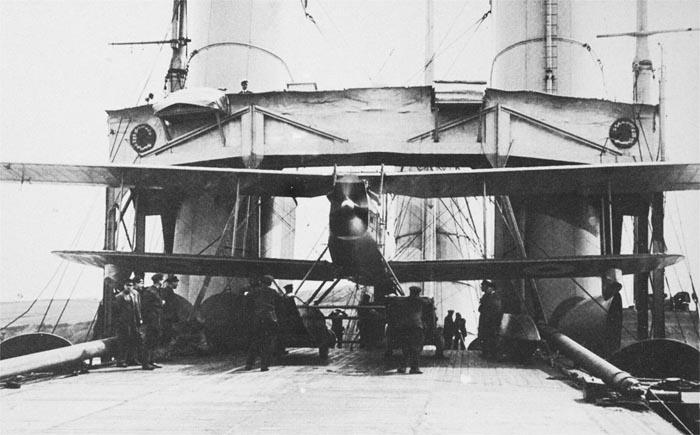
Fairey Campania, wings unfolded, just out of the forward hold, coming from below the flying bridge of HMS Campania.
The Royal Navy was started carrier aviation, converting many civilian ships to carry early floatplanes, and by the autumn of 1914, one of them was liner Campania, conversed into a seaplane carrier with a short span flight deck forward (36.6 m long) and two holds for a dozen of seaplanes. However it was found complicated to move seaplanes by cranes and in the water from the aftermost hold to the flight deck, or even to launch relatively heavy models dur to the short lenght of the deck.
A tailored folding wings model
Operating seaplanes in these early days of 1915 showed the improvements to make, and thus HMS Campania was completely overhauled, with many changed to make her able to launch much larger seaplanes, but also land planes as well, with nearly all RNAS models tested aboard. Still, these models, like the Short S184 had a large span and required the carrier to stop completely to hoist the aircraft out, transfer it in-board by crane, and all by calm seas, perfect conditions for an U-boat to attack and make an easy kill. This, the Admiralty started to look after alternatives and by-1916, thanks to the new 200 ft (61 m) or lengthened by 24.4 m flight deck forward and better transfer capabilities from not only the forward but also back hold, the Admiralty issued a specification for a purpose-built, two-seat patrol and reconnaissance aircraft which featured innovation would be foldable wings, something that never has been done before.
Thus, Fairey Aviation came out rapidly with its own design. This was a single-engined tractor biplane, fabric-covered and of wooden construction, two seats and two-bay. The prototype first flew on 16 February 1917. What the admiralty appreciated was its simple yet effective system to have its two-bay wings folding rearwards for storage. It was done thanks to a system where only the forward main structural spar was connected to the inner part of the wings attached to the fuselage by a simple axial hinge. The rotation could be done by reloving a simple pin, and folding made by two operators in record time, as unfolding. This spared a lot of complications by trying not to harm the plane from the hold to the flight deck, and enabled the storage of even more aircraft, up to 14 versus 10 at the start.
Final development and production
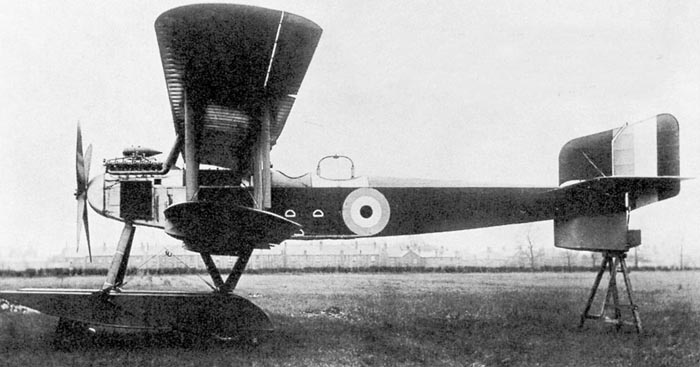
The first prototype of this model was named F.16 Campania, powered by a 250 hp Rolls-Royce Mk IV (then Eagle IV) engine, 186 kW. It first flew on February 16, 1917. Then the second prototype, the F.17 Campania took off in June equipped with an Eagle V engine. A total of 62 were assembled, of which 50 were built by Fairey, and the rest were subcontracted to Barclay, Curie & Co. (Clydeside). Indeed, 170 aircraft were ordered, but only 62 were completed.
Detailed Design
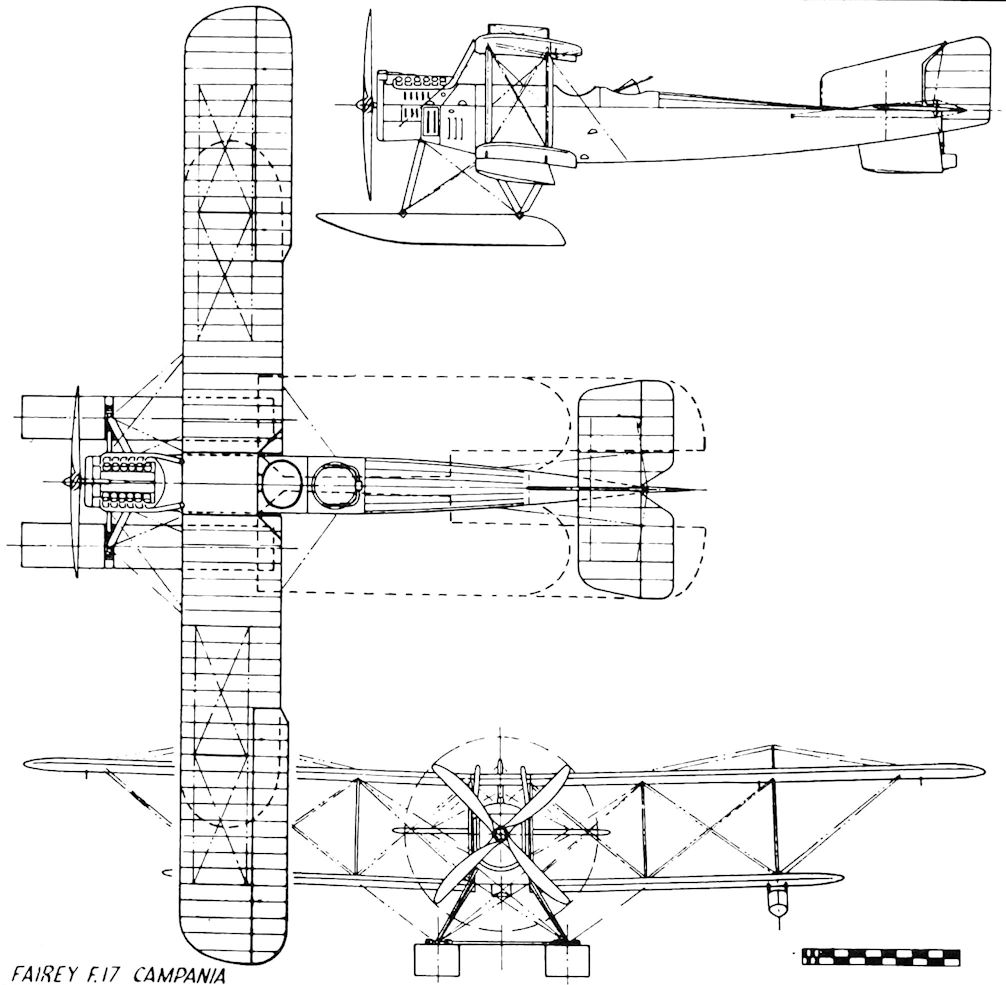
The Fairey Campania as said was at first ordered to just 10 preserie models with a specific engine (see later) and had a standard, rectangular fuselage, assembled from wooden stringers and frames, covered with well-treated canvas, while the engine frame and panels of the forward fuselage were made of metal. There were frontal or two side radiators depending on the engine. Various engines were installed from the Rolls-Royce “Eagle VIII” (360 hp) or Sunbeam “Mayori II” (250 hp). Fuel tanks and oil tanks were installed behind the engine. Next were the cockpits of the pilot and gunner-observer.

The wing was two-spar and all-wooden construction covered with fabric. To ensure rigidity, the upper wing had tensioner cables. Racks in fairings made of wood ensured extra transverse rigidity. Its tailed was low by long, with a stabilizer adjustable on the ground fastened with struts and stretch marks. Rudder and ailerons control only on the upper wing were made by cable, from the steering wheel and pedals. The pontoon-type floats were of wooden construction, attached to the fuselage by six metal posts. The wooden tail and underwing floats were made flush with the wing.
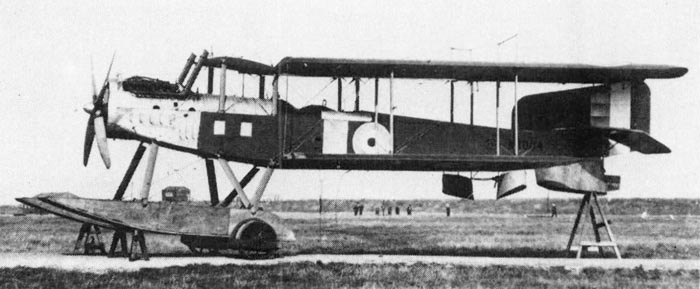
Fairey Campania, wings folded
Armament consisted of one or two 0.3-in or 7.62-mm Lewis, cheesebox magazine-fed machine guns ion the rear flexible mount or scarff ring. There was the possibility of even installing a small bomb load, with two 30-kg bombs under the wing. The Campania turned out to be a reliable reconnaissance and patrol aircraft and at the end of 1917, Fairey created a smaller and lighter version of the F.17 for experiments with catapults.
Engines (Variants)
Only three variants were made, all having different engines. They were the following:
Campania F.16: 250 hp (190 kW) Rolls-Royce Eagle IV: 1st prototype
Campania F.17: 275 hp (205 kW) Rolls-Royce Eagle V (reenginered later 345 hp (257 kW) Eagle III): 2nd prototype
Campania F.22: 260 hp (194 kW) Sunbeam Maori II; Production version.
By the time the Campania went into production, high demand for Rolls-Royce engines led to chossing instead the 260 hp Sunbeam Maori II engine rated for 194 kW. This required a number of changes to the design of the cooling systems and removal of combustion products. Maori engines were installed in 25 F.22 Campanias. Such machines were operated from coastal airfields, not from HMS Campania. Some later models still around in 1919 were equipped with the 345 hp Eagle VIII engine (F.17) and 257 kW or 325 hp Eagle VII engines. However flight characteristics remained low.
A short Operational Life
If trials were proving satisfactory in the winter of 1917 production went on for the F.17 to be shipped aboard the carriers HMS Campania, HMS Nairana and HMS Pegasus. Unlike the two others, only Campania possessed a flight deck and the launch was done thanks to jettisonable wheeled bogies fitted to the floats, retreived each time. On the two other ships, took operations were much slower as the Campanias needed to be lowered to the water by crane, flew off and were retrieved the same way. Deck launch at least enabled a much faster pace and was less dependent from sea state.
The 27 F.22s operated from various Royal Naval Air Service air stations. Outside of the RNAS, the Campania served with No. 240 Squadron, No. 241 Squadron and No. 253 Squadron of the RAF. The Campania had an undistinguished career, but performed a useful spotter work. Operating from the still surviving Nairana and Pegasus, the model found use with the British Expeditionary Force operating in Arkhangelsk (Russia) in 1919. Operations however started already on 1 August 1918, during the North Russia Campaign, and only later with the British intervention in the Civil War.
Campanias from HMS Nairana took part even in the the first fully combined air, sea, and land military operation, driving Bolsheviks out of their fortifications on Modyugski Island (mouth of the Northern Dvina). It also scouted ahead of the Allied force proceeding up the channel to Arkhangelsk. Their mere presence has Bolshevik leaders fleeing, and Campanias from Nairana started from there to operate from Arkhangelsk, and against the White Finnish defensive positions in Uhtua (autumn of 1918), from Kem. This was the model’s last hurrah, as it was declared obsolete in August 1919.
Aviation nerds all knows a simple fact: When a plane is too specialized, it’s not always a key for success, and as the situation evolved is does always not fit the changes. The Fairey Campania, despite its merits, was oartly one of these. It had a key feature, folding wings, but overall was less brillant tha, the Short 184, and overall, it arrived too late. Production was cut short and in the end, it just faded from the pages of history, and i feel it’s a bit unfair, as it had no issue.
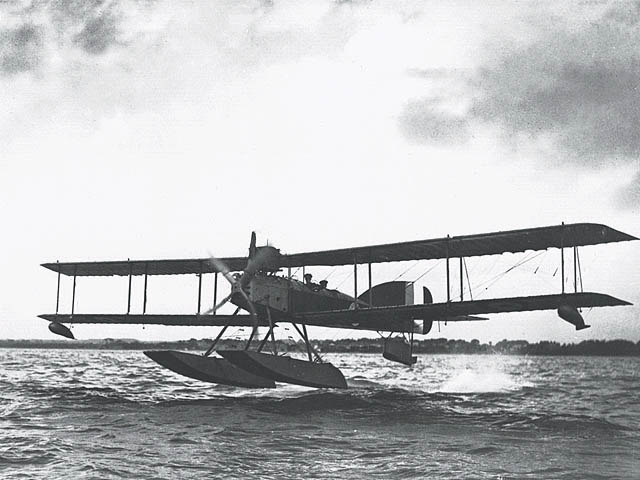
The Campania suffered the comparison with the Short S.184, produced ten times more and with better performances overall.
⚙ Fairey Campania F.22 specifications |
|
| Empty Weight | 3,672 lb (1,666 kg) |
| Gross weight | 5,329 lb (2,417 kg) |
| Lenght | 43 ft 1 in (13.13 m) |
| Wingspan | 61 ft 7 in (18.77 m) |
| Height | 15 ft 1 in (4.60 m) |
| Wing Area | 674.6 sq ft (62.67 m2) |
| Wing Loading | 7.90 lb/sq ft (38.6 kg/m2) |
| Power/mass | 0.049 hp/lb (0.081 kW/kg) |
| Engine | Sunbeam Maori II V-12 water-cooled piston engine, 260 hp (190 kW), 2-bladed fixed-pitch propeller |
| Top Speed, sea level | 85 mph (137 km/h, 74 kn) |
| Cruise Speed | |
| Range/Autonomy | 4 hours 30 minutes |
| Climb Rate | 2,000 ft (610 m) in 7 minutes |
| Ceiling | 6,000 ft (1,800 m) |
| Armament | 1× .303 in (7.7 mm) Lewis, 6× 116 lb (53 kg) bombs underwings/fuselage. |
| Crew | 2: Pilot, MG-gunner/observer |
Read More/Src
Books
Bruce, J.M. “Fairey Campania”. Air Pictorial, May 1963. pp. 142–145.
Munson, Kenneth. Flying Boats and Seaplanes since 1910. Blandford.
Taylor, H.A. Fairey Aircraft since 1915. London:Putnam, 1988.
Links
aviadejavu.ru
avionslegendaires.net
.armedconflicts.com
en.wikipedia.org
flyingmachines.ru
jnpassieux.fr
airwar.ru
aviastar.org
militaryfactory.com/
tangmere-museum.org.uk
Model Kits
F17 Karaya 1:72 on scalemates
Colin Owers – Great War Aviation Centennial Series Nr. 57, vol.3 Fairey Campania
Gallery
Illustrations
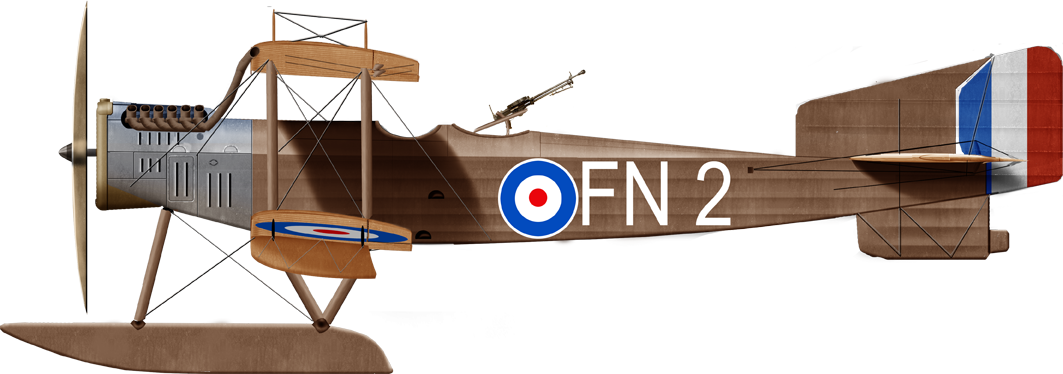
Photos
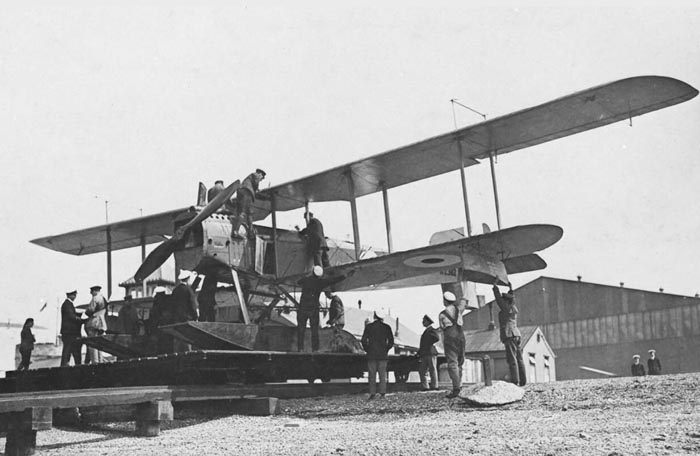
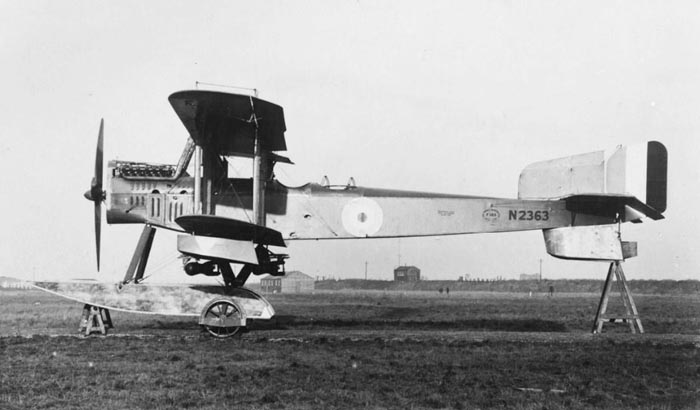
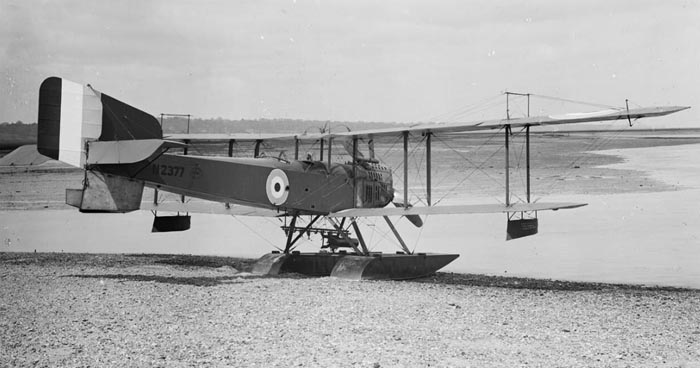
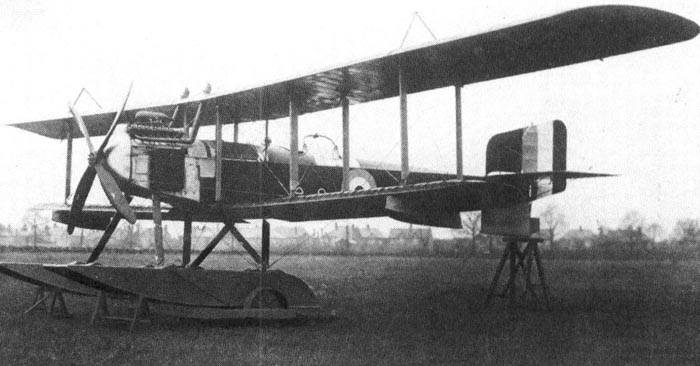
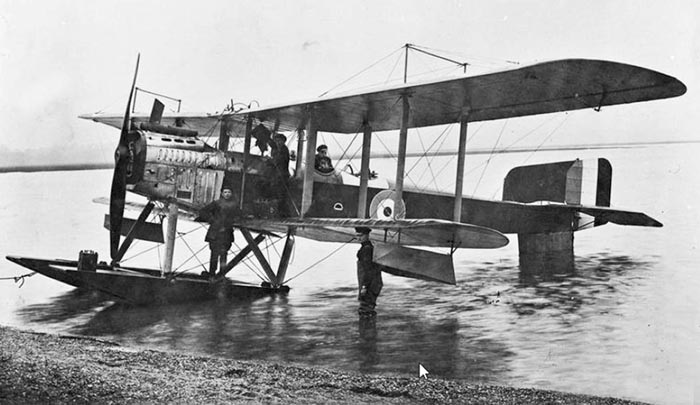
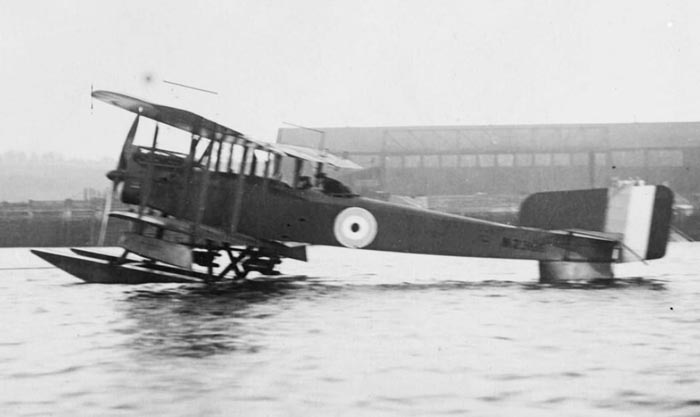
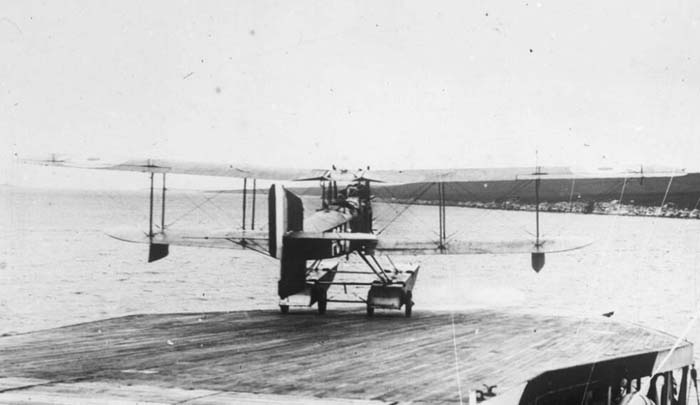
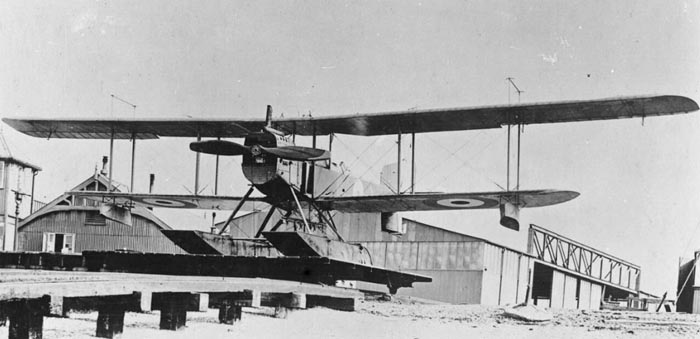
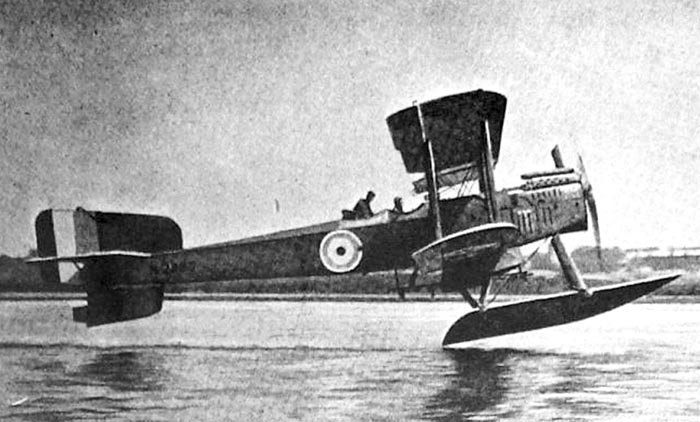
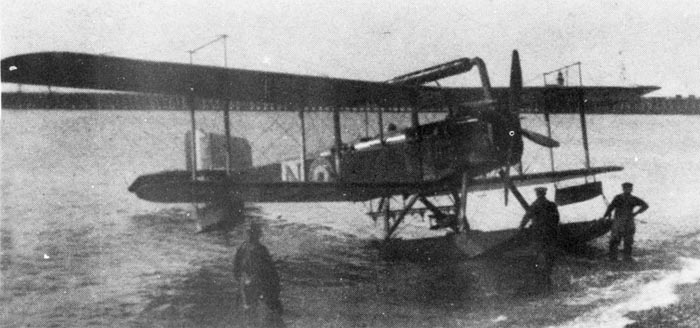
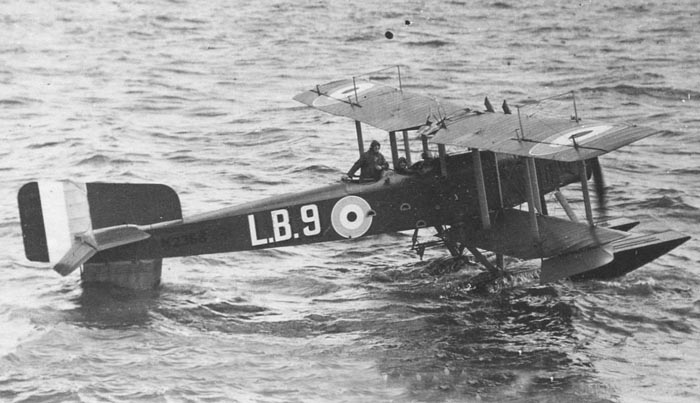

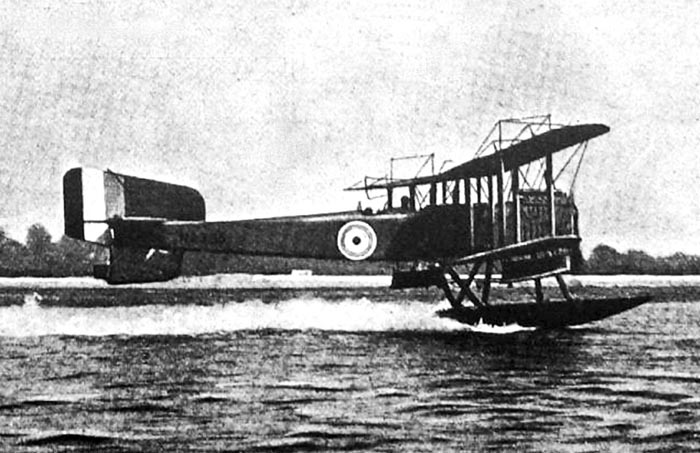
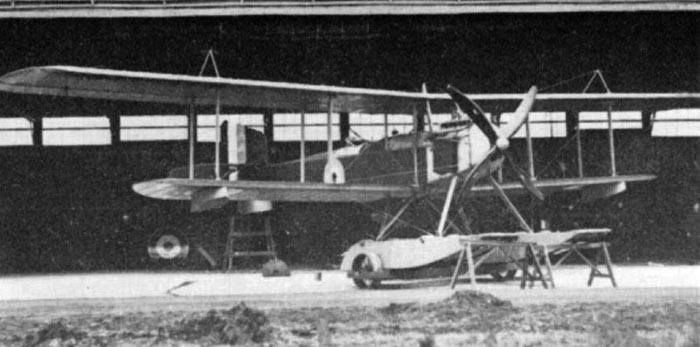



 Latest Facebook Entry -
Latest Facebook Entry -  X(Tweeter) Naval Encyclopedia's deck archive
X(Tweeter) Naval Encyclopedia's deck archive Instagram (@navalencyc)
Instagram (@navalencyc)





 French Navy
French Navy Royal Navy
Royal Navy Russian Navy
Russian Navy Armada Espanola
Armada Espanola Austrian Navy
Austrian Navy K.u.K. Kriegsmarine
K.u.K. Kriegsmarine Dansk Marine
Dansk Marine Nautiko Hellenon
Nautiko Hellenon Koninklije Marine 1870
Koninklije Marine 1870 Marinha do Brasil
Marinha do Brasil Osmanlı Donanması
Osmanlı Donanması Marina Do Peru
Marina Do Peru Marinha do Portugal
Marinha do Portugal Regia Marina 1870
Regia Marina 1870 Nihhon Kaigun 1870
Nihhon Kaigun 1870 Preußische Marine 1870
Preußische Marine 1870 Russkiy Flot 1870
Russkiy Flot 1870 Svenska marinen
Svenska marinen Søværnet
Søværnet Union Navy
Union Navy Confederate Navy
Confederate Navy Armada de Argentina
Armada de Argentina Imperial Chinese Navy
Imperial Chinese Navy Marinha do Portugal
Marinha do Portugal Mexico
Mexico Kaiserliche Marine
Kaiserliche Marine 1898 US Navy
1898 US Navy Sovietskiy Flot
Sovietskiy Flot Royal Canadian Navy
Royal Canadian Navy Royal Australian Navy
Royal Australian Navy RNZN Fleet
RNZN Fleet Chinese Navy 1937
Chinese Navy 1937 Kriegsmarine
Kriegsmarine Chilean Navy
Chilean Navy Danish Navy
Danish Navy Finnish Navy
Finnish Navy Hellenic Navy
Hellenic Navy Polish Navy
Polish Navy Romanian Navy
Romanian Navy Turkish Navy
Turkish Navy Royal Yugoslav Navy
Royal Yugoslav Navy Royal Thai Navy
Royal Thai Navy Minor Navies
Minor Navies Albania
Albania Austria
Austria Belgium
Belgium Columbia
Columbia Costa Rica
Costa Rica Cuba
Cuba Czechoslovakia
Czechoslovakia Dominican Republic
Dominican Republic Haiti
Haiti Hungary
Hungary Honduras
Honduras Estonia
Estonia Iceland
Iceland Eire
Eire Equador
Equador Iran
Iran Iraq
Iraq Latvia
Latvia Liberia
Liberia Lithuania
Lithuania Mandchukuo
Mandchukuo Morocco
Morocco Nicaragua
Nicaragua Persia
Persia San Salvador
San Salvador Sarawak
Sarawak Uruguay
Uruguay Venezuela
Venezuela Zanzibar
Zanzibar Warsaw Pact Navies
Warsaw Pact Navies Bulgaria
Bulgaria Hungary
Hungary

 Bundesmarine
Bundesmarine Dutch Navy
Dutch Navy Hellenic Navy
Hellenic Navy Marina Militare
Marina Militare Yugoslav Navy
Yugoslav Navy Chinese Navy
Chinese Navy Indian Navy
Indian Navy Indonesian Navy
Indonesian Navy JMSDF
JMSDF North Korean Navy
North Korean Navy Pakistani Navy
Pakistani Navy Philippines Navy
Philippines Navy ROKN
ROKN Rep. of Singapore Navy
Rep. of Singapore Navy Taiwanese Navy
Taiwanese Navy IDF Navy
IDF Navy Saudi Navy
Saudi Navy Royal New Zealand Navy
Royal New Zealand Navy Egyptian Navy
Egyptian Navy South African Navy
South African Navy






























 Ukrainian Navy
Ukrainian Navy dbodesign
dbodesign